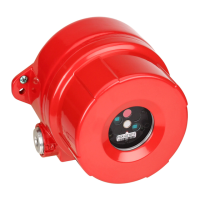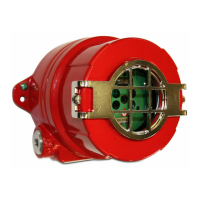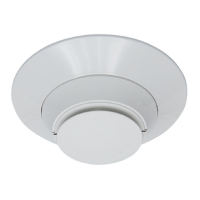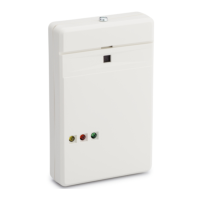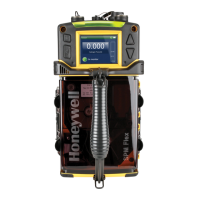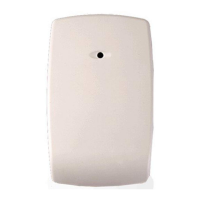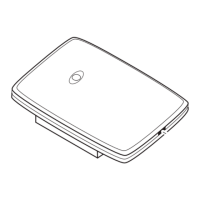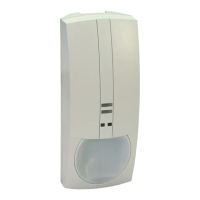Do you have a question about the Honeywell FSL100-IR3 and is the answer not in the manual?
Specifies who should read this manual and who is authorized for installation and service.
Provides general safety warnings and cautions applicable to the FSL100 Flame Detectors.
Notes on manual usage, applicability, and types of notices used in the document.
Highlights the built-in safety features of the FSL100 series flame detectors.
Guidance on the number, type, and placement of fire detectors and alarm control systems.
General guidelines for flame detector system design including mounting and orientation.
Details the options for installing the FSL100 series of Flame Detectors, including swivel mount.
Explains the cone of vision for the FSL100 flame detector and its coverage range.
Describes how to avoid shadow effects by proper detector mounting height relative to objects.
Provides guidance on mounting height to avoid smoke interference with detector sensitivity.
Explains the 'voting-system' configuration where alarm output depends on multiple detector inputs.
Recommendations for protecting the flame detector from environmental elements like sunlight, rain, and snow.
Discusses potential false alarms from hot work and how to manage them.
Details the power supply requirements and cable data for the FSL100 flame detectors.
Provides recommendations for suitable field cable and gland installation for the FSL100.
Outlines the correct procedures for connecting and managing earth (ground) connections.
Illustrates the FSL100 wiring diagram and provides terminal allocation details.
Explains general wiring options and essential electrical connection procedures for the flame detector.
Details how to wire the FSL100 flame detector to a general controller, including cable gland usage.
Describes the method for connecting the FSL100 flame detector to a fire control panel using current increase.
Illustrates how to wire the FSL100 flame detector to a Programmable Logic Controller (PLC).
Explains the wiring for a 4-20 mA non-isolated sourcing current output from the FSL100.
Details how to incorporate a manual self-test switch for the FSL100 detector.
Explains how to configure the latching or unlatching alarm settings using DIL switch 3.
Provides a step-by-step guide for commissioning the FSL100 flame detector before activation.
Details the procedures for regularly testing the FSL100 flame detector's functionality.
Explains common causes of false alarms and how to perform fault analysis on the FSL100.
Outlines the steps for performing fault testing on the FSL100 flame detector and troubleshooting steps.
Explains the meaning of the green, yellow, and red LEDs on the FSL100 display for status indication.
Details the normal operating status, including fire alarm conditions and relay output behavior.
Describes how fault conditions are indicated by LEDs and how the system behaves during faults.
Explains the functionality of the Alarm and Fault relays, including latching and unlatching options.
Details the values of the 0-20 mA sourcing output for different operational states.
Describes the automatic and manual self-testing procedures for the FSL100 detector.
Details how to perform a manual self-test on the FSL100 detector using a switch or terminals.
Step-by-step instructions for installing the FSL100 detector using the SM21 swivel mounting.
Instructions on how to clean the detectors and mountings, emphasizing safe practices.
Crucial safety instructions for using the FSL100-TL test lamp in safe areas.
Steps for preparing the FSL100-TL test lamp for its initial operation, including battery charging.
Guidance on operating the FSL100-TL test lamp for testing flame detectors.
Instructions for charging and storing the battery for the FSL100-TL test lamp.
Procedure for replacing the bulb in the FSL100-TL test lamp, recommending competent personnel.
Essential safety instructions for using the FSL100-TLX test lamp in hazardous areas.
Instructions for initial setup of the FSL100-TLX test lamp in a safe area.
Guidance on operating the FSL100-TLX test lamp for testing flame detectors in hazardous areas.
Procedure for replacing the batteries in the FSL100-TLX test lamp.
States that a full EC declaration of conformity is available, listing European Standards.
Lists ATEX, IECEX, FM, and CPR certificates and their respective standards and codes.
Details the information found on the EN54-10/ATEX/IECx and FM rating labels for the FSL100.
Details North American approvals including cFMus class 3611 and FM class 3260 for the FSL100.
Specifies who should read this manual and who is authorized for installation and service.
Provides general safety warnings and cautions applicable to the FSL100 Flame Detectors.
Notes on manual usage, applicability, and types of notices used in the document.
Highlights the built-in safety features of the FSL100 series flame detectors.
Guidance on the number, type, and placement of fire detectors and alarm control systems.
General guidelines for flame detector system design including mounting and orientation.
Details the options for installing the FSL100 series of Flame Detectors, including swivel mount.
Explains the cone of vision for the FSL100 flame detector and its coverage range.
Describes how to avoid shadow effects by proper detector mounting height relative to objects.
Provides guidance on mounting height to avoid smoke interference with detector sensitivity.
Explains the 'voting-system' configuration where alarm output depends on multiple detector inputs.
Recommendations for protecting the flame detector from environmental elements like sunlight, rain, and snow.
Discusses potential false alarms from hot work and how to manage them.
Details the power supply requirements and cable data for the FSL100 flame detectors.
Provides recommendations for suitable field cable and gland installation for the FSL100.
Outlines the correct procedures for connecting and managing earth (ground) connections.
Illustrates the FSL100 wiring diagram and provides terminal allocation details.
Explains general wiring options and essential electrical connection procedures for the flame detector.
Details how to wire the FSL100 flame detector to a general controller, including cable gland usage.
Describes the method for connecting the FSL100 flame detector to a fire control panel using current increase.
Illustrates how to wire the FSL100 flame detector to a Programmable Logic Controller (PLC).
Explains the wiring for a 4-20 mA non-isolated sourcing current output from the FSL100.
Details how to incorporate a manual self-test switch for the FSL100 detector.
Explains how to configure the latching or unlatching alarm settings using DIL switch 3.
Provides a step-by-step guide for commissioning the FSL100 flame detector before activation.
Details the procedures for regularly testing the FSL100 flame detector's functionality.
Explains common causes of false alarms and how to perform fault analysis on the FSL100.
Outlines the steps for performing fault testing on the FSL100 flame detector and troubleshooting steps.
Explains the meaning of the green, yellow, and red LEDs on the FSL100 display for status indication.
Details the normal operating status, including fire alarm conditions and relay output behavior.
Describes how fault conditions are indicated by LEDs and how the system behaves during faults.
Explains the functionality of the Alarm and Fault relays, including latching and unlatching options.
Details the values of the 0-20 mA sourcing output for different operational states.
Describes the automatic and manual self-testing procedures for the FSL100 detector.
Details how to perform a manual self-test on the FSL100 detector using a switch or terminals.
Step-by-step instructions for installing the FSL100 detector using the SM21 swivel mounting.
Instructions on how to clean the detectors and mountings, emphasizing safe practices.
Crucial safety instructions for using the FSL100-TL test lamp in safe areas.
Steps for preparing the FSL100-TL test lamp for its initial operation, including battery charging.
Guidance on operating the FSL100-TL test lamp for testing flame detectors.
Instructions for charging and storing the battery for the FSL100-TL test lamp.
Procedure for replacing the bulb in the FSL100-TL test lamp, recommending competent personnel.
Essential safety instructions for using the FSL100-TLX test lamp in hazardous areas.
Instructions for initial setup of the FSL100-TLX test lamp in a safe area.
Guidance on operating the FSL100-TLX test lamp for testing flame detectors in hazardous areas.
Procedure for replacing the batteries in the FSL100-TLX test lamp.
States that a full EC declaration of conformity is available, listing European Standards.
Lists ATEX, IECEX, FM, and CPR certificates and their respective standards and codes.
Details the information found on the EN54-10/ATEX/IECx and FM rating labels for the FSL100.
Details North American approvals including cFMus class 3611 and FM class 3260 for the FSL100.
| Product Type | Flame Detector |
|---|---|
| Field of View | Horizontal 90°, Vertical 90° |
| Humidity | Up to 95% RH (non-condensing) |
| Approvals | FM, ATEX, IECEx |
| Housing Material | Stainless Steel |
| Detection Technology | Infrared (IR3) |
| Operating Temperature | -40°C to +70°C |


